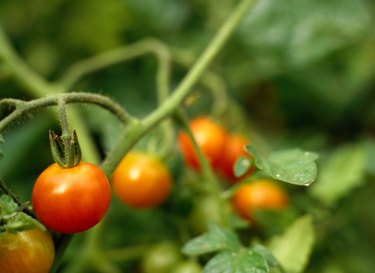Things You'll Need
Shovel
Bucket
Newspaper
Sandwich bag
Rototiller
Composted manure
Peat moss
Compost
Lime
Garden hose
Rain gauge
Tomato cage

Florida's warm tropical climate affects the methods by which Florida gardeners can grow tomatoes. Although central Florida is not quite as warm as southern Florida, the area falls within U.S. Department of Agriculture (USDA) hardiness zone 9, which means that winter lows never dip below 20 degrees Fahrenheit. Gardening conditions in Florida are the exact opposite of gardening in the rest of the country. Instead of growing tomatoes from late spring until early fall, Florida gardeners can grow tomatoes through the fall, winter and spring. Summer heat is often too warm to grow tomatoes well.
Step 1
Select a location for your garden in well-drained soil and full sun. Tomatoes need at least six hours of sun daily to produce fruit. Tomatoes that do not get enough sunlight will not produce fruit.
Video of the Day
Step 2
Dig 1 qt. of soil from 10 random locations across your garden. Mix this soil in a bucket and spread it over a newspaper to dry in the sun. Collect 2 cups of soil in a plastic sandwich bag and take the soil to your nearest University of Florida IFAS County Extension Office. An agent with the extension service will help you to fill out paperwork and submit the soil test to the University of Florida IFAS Extension Soil Testing Laboratory. The test results will indicate the pH of your soil and make recommendations to improve the soil. The proper pH for growing tomatoes in Florida soil is between 5.8 and 6.3.
Step 3
Break up your soil to a depth of 12 inches with a rototiller. Spread organic material such as composted manure, peat moss and compost over the soil at a rate of 3 cubic yards per 1,000 square feet. Florida soil is extremely sandy and will benefit from organic additions. These amendments will add nutrients to the soil and help it to hold moisture. You should also add the amount of lime recommended by the soil test to shift the soil's pH into the proper range.
Step 4
Select tomato transplants that are adapted to Florida's warm climate. Good varieties for Florida, according to the University of Florida, include the indeterminate varieties Tropic, Better Boy and Bonnie Best, Sweet 100, Red Cherry and Sweet Million. Good determinate varieties include Suncoast, Floramerica, Flora-Dade, Solar Set, Roma, Micro Tom, Floragold, Florida Basket and extra-large tomato varieties such as Beefmaster and Beefsteak. Transplants should be between 4 and 5 inches high. Larger transplants will not produce fruit as abundantly.
Step 5
Open planting holes for tomato root balls in the soil. The tomato should be set slightly deeper in the soil than it grew in the flat. Place the tomato root ball in the planting hole and cover with soil. The best time to transplant tomatoes is after a rain, when it is cloudy or during late afternoon.
Step 6
Water tomatoes thoroughly once per week. Keep a rain gauge in your garden with your tomatoes to determine how much rainfall they have received and help you determine how much water you should use. Tomatoes need the equivalent of 2 inches rainfall each week.
Step 7
Mulch around tomatoes with pine bark mulch to hold water into the roots and to choke out weeds.
Step 8
Insert a tomato cage into the ground around indeterminate varieties of tomato. These tomatoes grow tall and need the support of the tomato cage to hold them off of the ground.
Tip
Tomato plants produce best at temperatures between 75 and 85 degrees. Tomatoes can be overwintered in cooler areas by protecting plants against frost and freezing weather. Some gardeners do not choose to grow tomatoes in winter and instead start determinant varieties that produce fruit sooner in fall and spring.
You can take cuttings of tomato plants in late spring and root them with rooting hormone in potting soil. Use these transplants in early fall to start a new crop of tomatoes.
Video of the Day